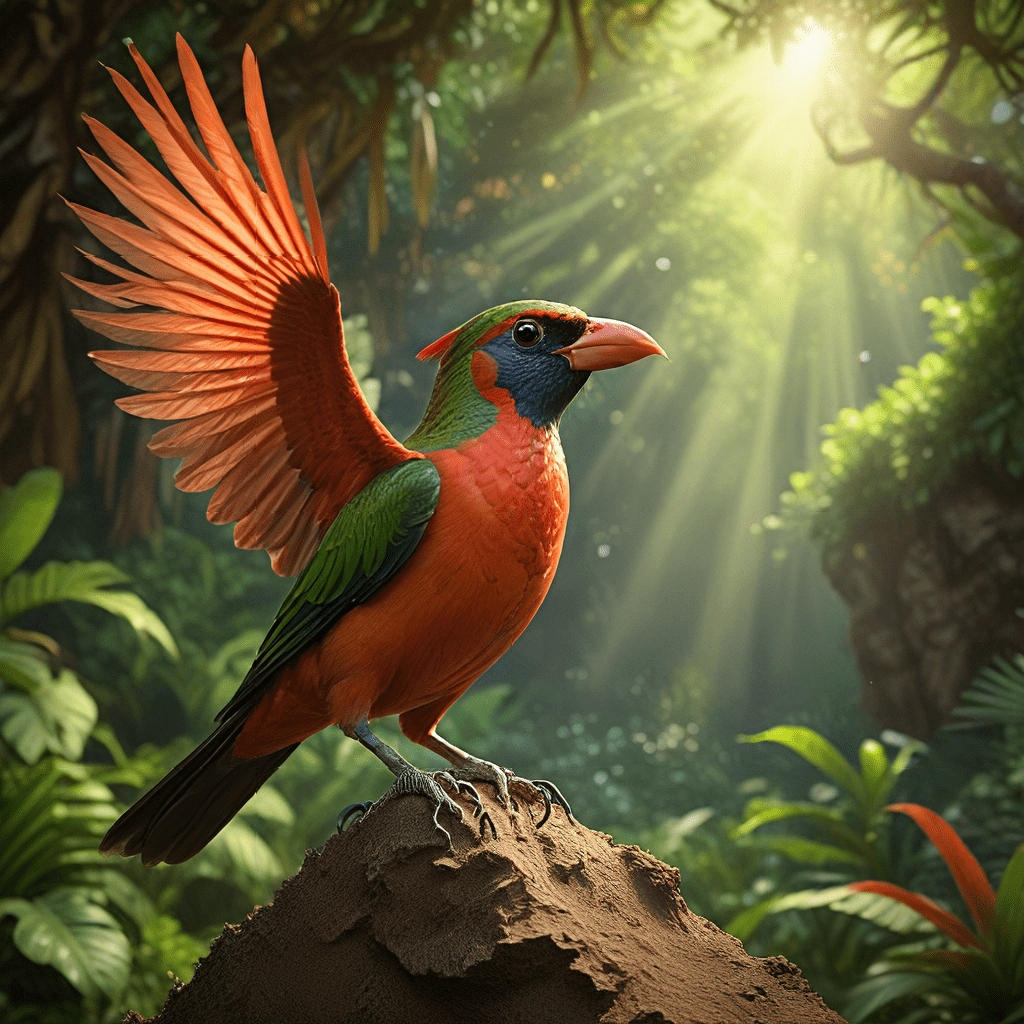Hawaiian Mythology: The Legend of the ‘I’iwi Bird
1. ‘I’iwi: A Symbol of Beauty and Song
In the rich tapestry of Hawaiian mythology, the 'I'iwi bird occupies a prominent place, symbolizing beauty, song, and spiritual connection. This vibrant crimson and yellow honeycreeper, with its long, curved beak, was more than just a feathered inhabitant of the islands; it was a revered creature woven into the very fabric of Hawaiian culture. The 'I'iwi's striking appearance and melodious song captured the attention and imagination of the ancient Hawaiians, leading them to incorporate this bird into their stories and traditions. The 'I'iwi's presence was a reminder of the beauty and wonder that surrounded them, connecting them to the natural world and the divine forces that shaped it.
2. The ‘I’iwi’s Vibrant Plumage: A Source of Legends
The 'I'iwi's striking red and yellow plumage, a striking contrast against the lush green foliage of the Hawaiian forests, fueled many legends. Its bright red feathers, reminiscent of the fiery sun, were believed to hold the essence of life and vitality. The ancient Hawaiians used these feathers to adorn their chiefs and high priests, symbolizing royalty, power, and spiritual connection. The 'I'iwi's feathers were also woven into elaborate headdresses and cloaks, serving as a reminder of the bird's divine association and the beauty it embodied. These feathers were highly prized and their acquisition was often linked to specific rituals and beliefs, reinforcing the 'I'iwi's significance within the cultural landscape.
3. The ‘I’iwi’s Song: A Connection to the Gods
The 'I'iwi's melodious song, often described as a flute-like melody, was believed to carry messages from the gods. Its sweet, haunting notes were seen as a conduit between the mortal world and the realm of the deities. The Hawaiians believed that the 'I'iwi could sing prophecies and convey messages from the gods, offering guidance and wisdom to those who listened attentively. The 'I'iwi's song was considered sacred and its presence in the forests was a sign of good fortune and divine favor. It was believed that if one listened carefully to the 'I'iwi's song, they could hear the whispers of the gods and gain insight into the mysteries of the universe.
4. The ‘I’iwi and the Creation Myth: A Role in the Genesis of the Islands
The 'I'iwi's presence in Hawaiian creation myths further solidified its importance in the islands' cultural heritage. In these stories, the 'I'iwi played a role in the shaping of the Hawaiian islands. Some legends describe the 'I'iwi as a messenger of the gods, carrying seeds of life and fertility throughout the land, giving birth to the lush vegetation that flourished on the islands. Other accounts depict the 'I'iwi as a guardian of the sacred places, protecting its home and ensuring the balance of the ecosystem. Through these myths, the 'I'iwi's connection to the origins of the islands became deeply ingrained in the Hawaiian worldview.
5. The ‘I’iwi and the Gods: Divine Companions and Messengers
The 'I'iwi was often associated with certain deities in Hawaiian mythology, particularly the god of music and dance, Lono, and the goddess of fire and volcanoes, Pele. Lono, with his connection to music and creativity, found a reflection in the 'I'iwi's beautiful song. Pele, known for her volatile nature and the fiery beauty of her volcanic eruptions, was said to be drawn to the vibrant red feathers of the 'I'iwi. The 'I'iwi's role as a messenger between the gods and mortals further cemented its importance in the spiritual realm. It was believed to carry messages of love, guidance, and warnings, bridging the gap between the divine and the human. This association with the gods reinforced the 'I'iwi's sacred status and its significance in Hawaiian society.
6. ‘I’iwi Transformation Myths: Human-Bird Transitions and Spiritual Significance
In some captivating Hawaiian myths, the 'I'iwi plays a central role in tales of human transformation into birds. These stories explore the deep connection between humans and the natural world, highlighting the spiritual potential within both. One such legend tells of a young woman who, heartbroken by a lover's betrayal, sought solace in the forest. As she mourned, she was enveloped by a magical mist and transformed into an 'I'iwi, its brilliant red feathers symbolizing her own fiery grief. Another myth tells of a brave warrior who, after a fierce battle, transformed into an 'I'iwi, his powerful song representing his strength and bravery. These myths suggest that the 'I'iwi is a symbol of transformation, representing the passage between life and death, the human and the divine, and the potential for spiritual growth. These stories underscore the reverence Hawaiians held for the 'I'iwi, seeing it as a symbol of hope, resilience, and the interconnectedness of all living things.
7. The ‘I’iwi and the Hawaiian Ecosystem: A Keystone Species in Myth and Reality
Beyond its mythical significance, the 'I'iwi, in real life, is a keystone species in the Hawaiian ecosystem, playing a crucial role in maintaining its delicate balance. This means that its role in the environment is essential for the survival of other species. The 'I'iwi's long, curved beak is perfectly adapted for feeding on nectar from the flowers of the ʻōhiʻa lehua tree, a vital part of the Hawaiian rainforest. In the process of feeding, the 'I'iwi spreads pollen, helping the ʻōhiʻa lehua trees reproduce and flourish. This interdependence between the 'I'iwi and the ʻōhiʻa lehua is a beautiful example of the intricate web of life that defines the Hawaiian ecosystem. Sadly, in recent times, the 'I'iwi population has declined due to habitat loss and the introduction of invasive species. This decline has a ripple effect throughout the ecosystem, affecting not only the ʻōhiʻa lehua trees but also other species that rely on them. The 'I'iwi's ecological role underscores its importance, not just in mythical stories, but also in the very survival of the Hawaiian rainforest and its unique biodiversity.
8. Theories of the ‘I’iwi’s Depiction in Mythology: Reflecting Hawaiian Values
The prominence of the 'I'iwi in Hawaiian mythology speaks to the deep reverence the ancient Hawaiians held for the natural world. The bird's beauty and its melodious song reflected the beauty and harmony of the island ecosystem. Its association with the gods and its role in creation myths emphasized the importance of maintaining balance and living in harmony with nature. These stories served as moral compass, encouraging behavior that honored and respected the environment. The 'I'iwi's depiction in mythology provided a powerful reminder of the interconnectedness of all things and the crucial role that humans play in maintaining ecological balance.
9. Theories of the ‘I’iwi’s Depiction in Mythology: A Link to Polynesian Origins
Some scholars believe that the 'I'iwi's depiction in Hawaiian mythology reflects the ancient Polynesian roots of Hawaiian culture. The 'I'iwi's association with the gods, its role in creation myths, and its significance in transformation stories are common themes found in the mythology of other Polynesian cultures. This suggests that these stories were carried with the Polynesian ancestors as they migrated across the Pacific Ocean, eventually settling in the Hawaiian Islands. These myths provided a shared cultural identity, connecting the Hawaiians to their ancestral heritage and reminding them of their journey across the vast ocean. The 'I'iwi, with its striking appearance and its deep connection to the Polynesian past, served as a potent symbol of this shared heritage.
10. The Enduring Legacy of the ‘I’iwi: A Symbol of Hawaiian Identity and Nature
The 'I'iwi continues to hold a special place in the hearts and minds of the Hawaiian people. It is a symbol of their cultural heritage, their connection to the natural world, and their reverence for beauty and song. The 'I'iwi's story is a reminder of the importance of protecting the environment, respecting the balance of nature, and cherishing the traditions that bind us to the past. As the 'I'iwi continues to face threats to its survival, its legacy serves as a powerful call to action, urging us to protect the delicate ecosystems we depend on and to preserve the beauty and wonder of the natural world.
FAQ
What is the 'I'iwi bird?
The 'I'iwi is a small, brightly colored honeycreeper bird endemic to the Hawaiian Islands. It is known for its striking red and yellow plumage and its beautiful, melodious song.
What is the 'I'iwi's role in Hawaiian mythology?
The 'I'iwi is a prominent figure in Hawaiian mythology, embodying beauty, song, and spiritual connection. It is associated with various deities and plays a role in creation myths and transformation stories.
Why is the 'I'iwi important to Hawaiian culture?
The 'I'iwi represents a significant part of Hawaiian identity, symbolizing their connection to nature, their reverence for beauty, and their cultural heritage. It is also considered a keystone species in the Hawaiian ecosystem, playing a vital role in maintaining the balance of the rainforest.
What is the current status of the 'I'iwi population?
The 'I'iwi population has been declining in recent times due to factors such as habitat loss and the introduction of invasive species. It is currently considered a species of concern and conservation efforts are underway to protect it.
How can I learn more about the 'I'iwi?
You can learn more about the 'I'iwi by visiting the websites of organizations dedicated to Hawaiian wildlife and conservation. You can also read books and articles about Hawaiian mythology and culture.




